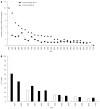Epidemiology of acute and chronic hepatitis B and delta over the last 5 decades in Italy
- PMID: 24976701
- PMCID: PMC4069292
- DOI: 10.3748/wjg.v20.i24.7635
Epidemiology of acute and chronic hepatitis B and delta over the last 5 decades in Italy
Abstract
The spread of hepatitis B virus (HBV) infection has gradually decreased in Italy in the last 5 decades as shown by the steady reduction in the incidence rates of acute hepatitis B, from 10/100000 inhabitants in 1984 to 0.85/100000 in 2012, and by the reduced prevalence of hepatitis B surface antigen (HBsAg)-positive cases among chronic hepatitis patients with different etiologies, from 60% in 1975 to about 10% in 2001. The prevalence of HBsAg chronic carriers in the general population also decreased from nearly 3% in the 1980s to 1% in 2010. Linked to HBV by its characteristics of defective virus, the hepatitis delta virus (HDV) has shown a similar epidemiological impact on the Italian population over time. The incidence of acute HDV infection decreased from 3.2/100000 inhabitants in 1987 to 0.8/100000 in 2010 and the prevalence of HDV infection in HBsAg chronic carriers decreased from 24% in 1990 to 8.5% in 2006. Before the beneficial effects of HBV mass vaccination introduced in 1991, the decreased endemicity of HBV and HDV infection in Italy paralleled the improvement in screening blood donations, the higher standard of living and impressive reduction in the birth rate associated with a marked reduction in the family size. A further contribution to the decline in HBV and HDV infections most probably came from the media campaigns to prevent the spread of human immunodeficiency virus infection by focusing the attention of the general population on the same routes of transmission of viral infections such as unsafe sexual intercourse and parenteral exposures of different kinds.
Keywords: Acute hepatitis B; Acute hepatitis delta; Chronic viral hepatitis; Hepatitis B virus epidemiology; Hepatitis delta virus epidemiology.
Figures

References
-
- Lavanchy D. Worldwide epidemiology of HBV infection, disease burden, and vaccine prevention. J Clin Virol. 2005;34 Suppl 1:S1–S3. - PubMed
-
- European Association For The Study Of The Liver. EASL Clinical Practice Guidelines: management of chronic hepatitis B. J Hepatol. 2009;50:227–242. - PubMed
-
- Borgia G, Gentile I. Treating chronic hepatitis B: today and tomorrow. Curr Med Chem. 2006;13:2839–2855. - PubMed
Publication types
MeSH terms
LinkOut - more resources
Full Text Sources
Other Literature Sources
Medical

